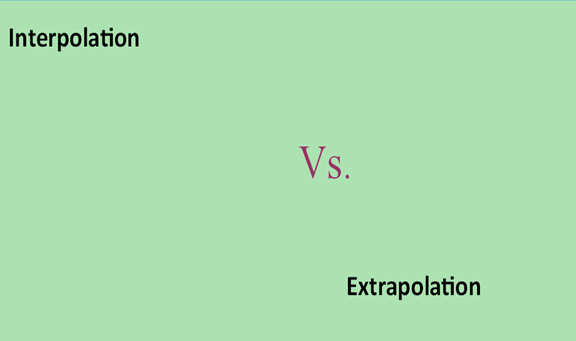Let us look at the differences between interpolation and Extrapolation.
1. Definition
Interpolation: interpolation is a statistical method that is useful in estimating unknown values by using known values.
The unknown value is usually between two known values and may appear like the midway of the two known points.
Extrapolation:
This is a statistical method used to predict unknown values for points outside the range of the recorded data. It is used to extend a known sequence of values beyond the sampled area.
2. Obtaining the unknown value
Interpolation: when this method is used, the unknown value(s) is obtained between the two known values. Therefore, the estimated value is within the sampled area.
Extrapolation: In this statistical method, the unknown values are obtained from the outside of the sampled area. The point chosen may either be above or below the known points.
3.Predictions
Interpolation: this method is largely used in predictions of data and values within the range. When working with this method, we can be confident that our predictions are realistic since their values are derived within the sampled area. True or close values are needed during curve fitting, and thus, the interpolation method may be more accurate than any other method.
Extrapolation: with Extrapolation, we can be less confident with the unknown values derived using this method. The method includes values from outside the sampled area, which makes the predictions diverge away from the true values. In curve fitting, this method is not preferred.
4. Possibility of retrieving a negative
Interpolation: interpolation method cannot retrieve negative answers. This is so because it does not allow one to include values outside the range. This limits it from being used in some statistical calculations that require to be extrapolated.
Extrapolation:
the ability to retrieve negative answers is one characteristic that makes it unique for interpolation. This statistical method allows one to extend the values in the range either forward or backward. This technique of extending values is responsible for attaining the negative values.
5. Values needed to perform each method
Interpolation: as discussed earlier, this technique mainly depends on two known values. It only works where there are two points, and the unknown value is obtained between the two points. For instance, let say we have two points as 4 and 8. Then, our unknown value can be 6.
Extrapolation: this technique only requires one known value. That is, either the upper value or the lower value. The unknown value is then extrapolated from this number either forward or backward.
6. Data limit
Interpolation: this technique has a defined data limit. You are only required to work with data/values within the given range. This may pose a challenge when one wants to introduce value outside the range.
Extrapolation: while in this statistical method, there is no set data limit. Therefore, the user can extrapolate the given value and introduce values outside the range, which may be beneficial when working with values outside the range.
In conclusion, it can be seen that the two technique differs greatly and each method is useful in its different way.



